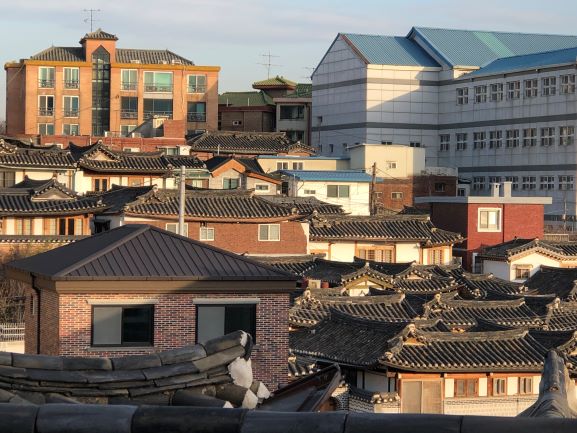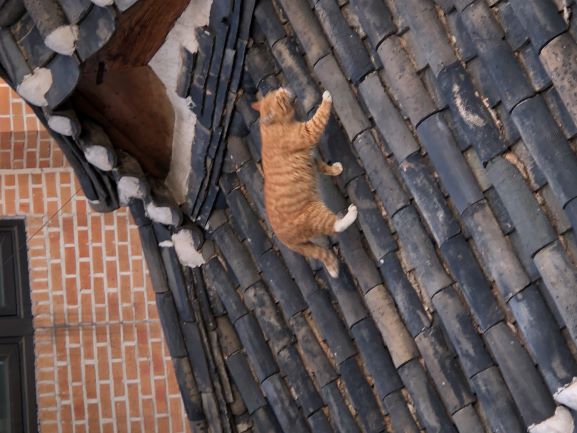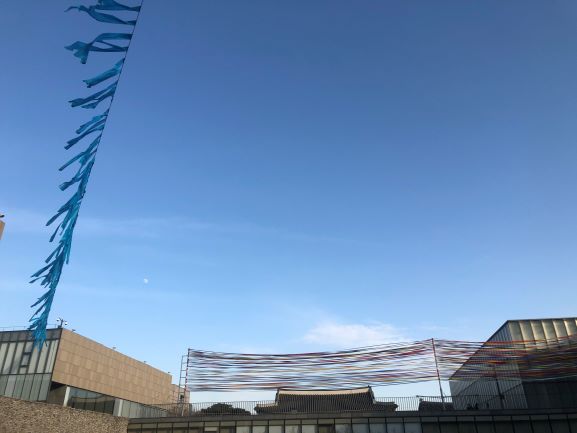Bukchon has a lot of diversity. Tourists and residents mingle together, people from different countries cross-paths, and there are many shops offering their own distinct personalities. The traditional Korean house, the hanok, and other more modern buildings stand side-by-side. There are many places to find hanoks in Seoul. Bukchon, however, is the best place to feel and experience the mood of ordinary people’s lives in the past. Since there are also modern buildings, Kingos can feel the coexistence of the past and the present. Today, the Sungkyun Times (SKT) is going to introduce Bukchon, which is not far from the Humanities and Social Sciences campus.
Who Are You, Bukchon?
About Bukchon
Interestingly, Bukchon is not the actual name of the place. The areas of Gahoe-dong and Samcheong-dong are collectively known as ‘Bukchon’. This is because ‘Buk’ means the North, and ‘chon’ means the town, and it is located at the upper part of the Cheonggyecheon Stream and Jongno. These days, the representative place of Bukchon is Bukchon Hanok Village. It is a well-known place for not only Koreans but also foreign tourists. Just walking Bukchon’s street makes people feel like they have become time travelers because there are lots of hanoks. Bukchon was a residential area from the Joseon Dynasty, so the style of the buildings at that time is maintained. Bukchon preserved hanok towns and its historical scene until the 1960s. Nevertheless, in the 1980s, a massive development boom occurred in Seoul, and the hanok village in Bukchon was in danger of disappearing. To prevent eliminating Bukchon’s unique characteristics, the government implemented a policy named the Type Four Beauty District in 1983. However, there was not any discussion or agreement with the residents, so it was quite controversial to follow the policy. Then, the new policy for preserving Bukchon’s Hanok Village based on residents’ opinions was established in 2001. It helped residents to rebuild the interior of the old hanok while maintaining its outer appearance.
How to Get to Bukchon
Kingos on the Humanities and Social Sciences Campus have lots of ways to get to Bukchon. You can take the Jongno-02 bus and get off in front of the Saudi Embassy at Kyungnam Villa Station, which takes about 19 minutes. It would be good to visit if you have a 3-hour-gap between classes. For Kingos on the Natural Sciences Campus, it takes almost one hour. You should take the subway at Sungkyunkwan University Station and get off at Seoul City Hall Station (57m). After that, walk to the Press Center Station (5m), and ride the Jongno-11 bus to Samcheongdong Community Service Center (8m).

The Past Held in Bukchon’s Arms
Hanok Streets
➊ Gahoe-dong 31
Hanok street is the most famous area in Bukchon. There are a lot of people taking photos with the hanok’s walls. If you have ever heard of Bukchon and have any image of Bukchon, then it might be an image of this street. Four spots of “The Eight Views of Bukchon” are located in Gahoe-dong 31. The Eight Views of Bukchon are places that are good to take photos with their beautiful scenery. Since it is the most famous spot in Bukchon, the streets are mostly crowded all the time. If you want to take a picture without other people, you might have to visit here in the very early morning.
➋ Buckhon-ro 12
Bukchon-ro 12 is the place known as the Gahoe-dong Workshop Street, and there are various places where you can catch a glimpse of the past life. Various workshops such as pottery and Korean traditional handmade paper, hanji, line the street, and it is very beautiful to see the mingling of these two different activities in one place. It might make you imagine how ordinary citizens in the past lived and worked. Among the characteristic workshops, the SKT is going to introduce Han Sang-soo’s embroidery exhibition and workshop. It is located near the third place of the Eight Views of Bukchon. You can visit there from 10:00 to 17:00 with 2,000 won for the entrance fee. In contrast to the rustic size of most other hanok workshops, it is pretty large with a scale of about 330m2 . You can see the embroidery collection and related folklore of Han Sang-soo the owner of this workshop is the Korean Intangible Cultural Asset No.80. Sadly, taking pictures inside of the exhibition is forbidden. Instead, you can have a bird’s-eye view around this workshop. The view looking down onto the tiled roofs of the hanoks is another Eight Views of Bukchon.

Enjoying Hanoks
Just looking around might be insufficient to truly feel the atmosphere of the past. In which case, you can visit Simsimheon in Gahoe-dong. The entrance fee is 10,000 won and, you can get tea with that fee. Simsimheon is a hanok that was traditionally built-in the modern days in the traditional way. So, it is a “modern” hanok that takes the uniqueness of hanoks and makes up for the weakness. For example, you can enjoy the beauty of hanoks inside the Simsimheon, but the practical part, such as the toilet, is modernly reformed. This is quite a famous place for foreign visitors too. If you want to feel more about hanoks, there is also a hanok stay in Bukchon. You can be accommodated in a hanok and experience the history more deeply. It can be, however, a little bit expensive.

Modern Part of Bukchon
Jeongdok Public Library
Jeongdok public library is located on Bukchon-ro 5. It closes every first and third Wednesday and all holidays. You can enter for free since there is no entrance fee. But, available times and seats are currently limited due to the pandemic. You can find more information about the limitations at Jeongdok Public Library’s online site. Jeongdok Public library has a beautiful garden. You can relax or capture this beautiful scenery in your mind just like Jeongseon. The famous artist in Joseon Dynasty, Jeongseon, drew his Four Season-Drawing of Colors for Inwang Mountain at this garden. There is a pond with a waterwheel on the west side of the main building’s entrance; near there, flowers and trees make a beautiful sight. A movie, The Day He Arrives, directed by Hong Sang-soo, is set in Bukchon, and you can frequently find the library in the film. You can also feel the innocence of childhood while watching the children playing at the playground.
National Museum of Modern and Contemporary Art
The National Museum of Modern and Contemporary Art (MMCA) is on Samcheong-ro 30. Except for every Monday, the MMCA is open from 10:00 to 18:00; Wednesday and Saturday, it opens until 21:00. You have to pay 4,000 won to enter the MMCA, but these days, because of the pandemic, the entrance fee is free. You should remember, the MMCA is taking reservations on its online site for social distancing. There are also diverse exhibitions at the MMCA. The MMCA Collection Highlights 2020+ is exhibiting until April 25th. On the outside of the MMCA, the artist Lee Seung-taek installation work, Non-Art: The Inversive Act, can be found and is exhibiting until March 28th. So, it is worth visiting even though you didn’t book.

All the seasons of Bukchon are beautiful, but the spring of Bukchon is especially dazzling. If you have something going on with someone, the SKT highly recommends visiting Bukchon with that person. It is a perfect place to have a date. Of course, being with friends might still be a happy time, too.
